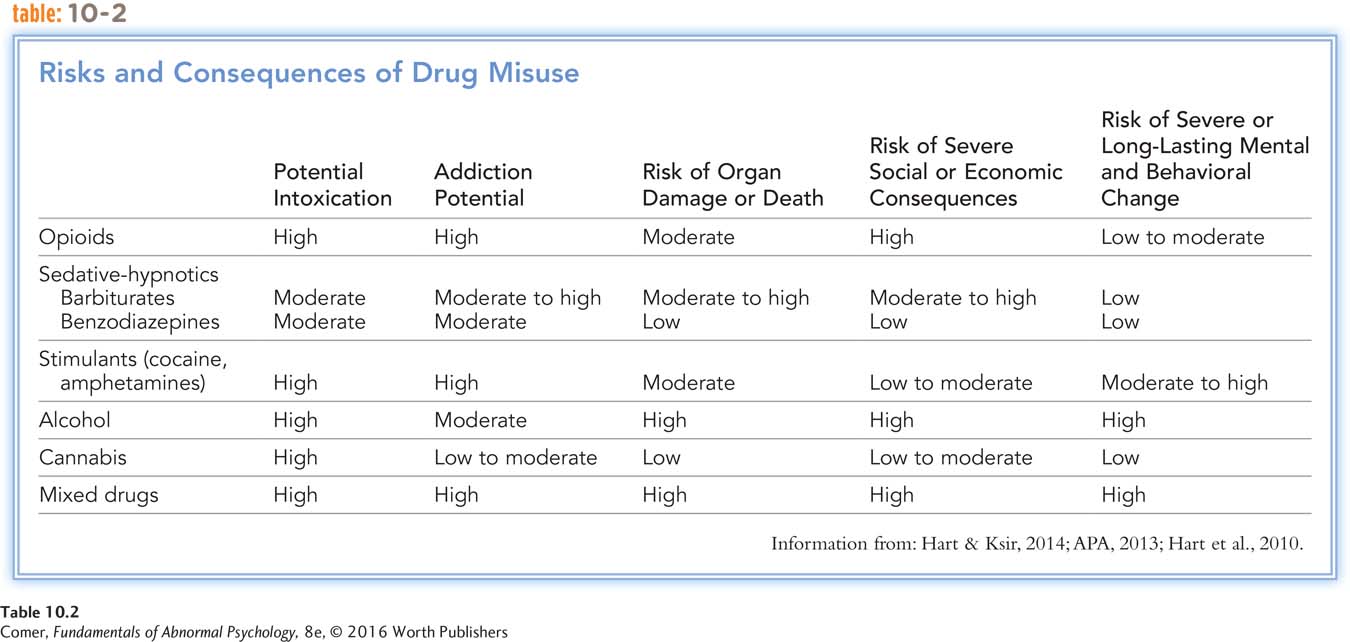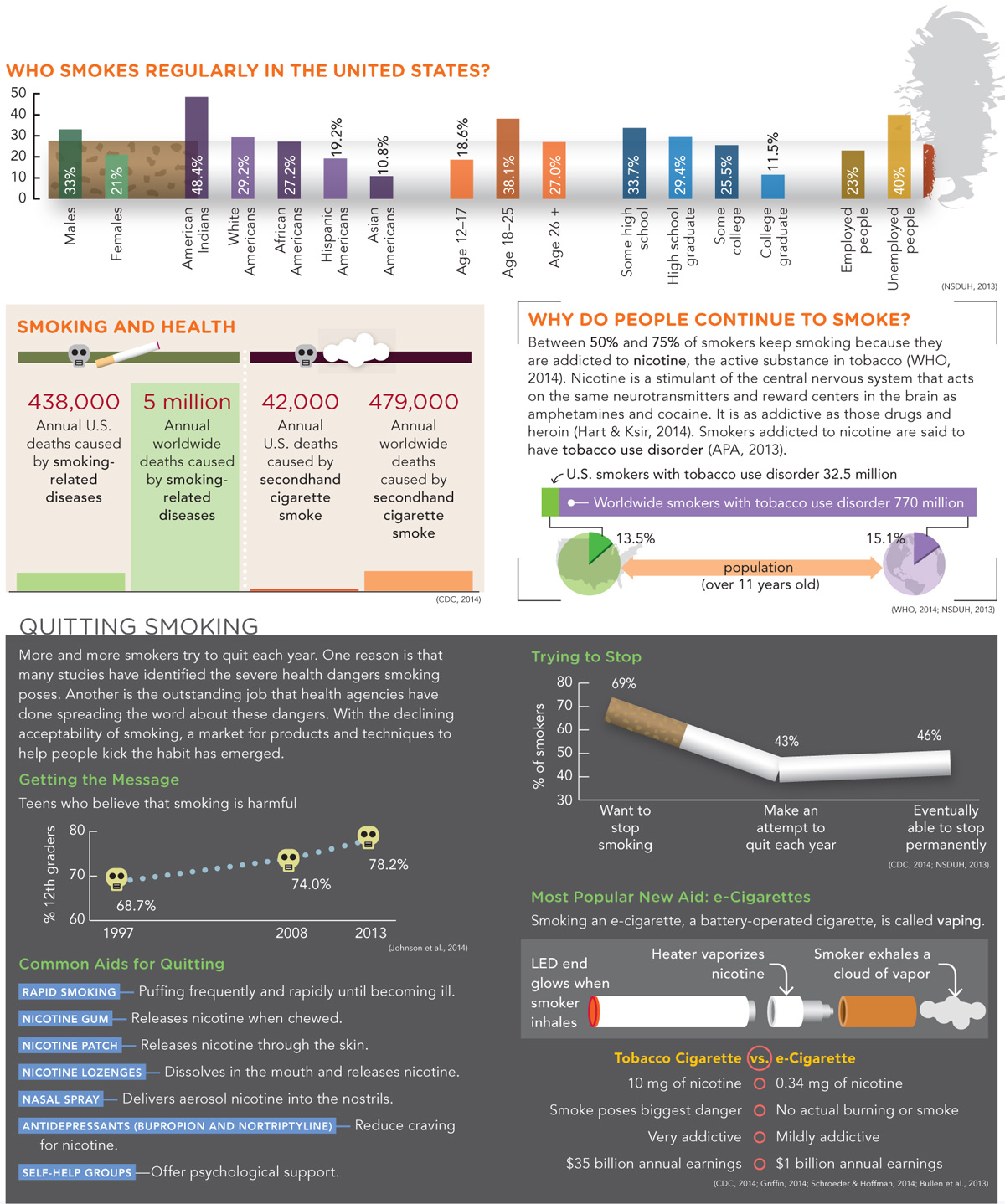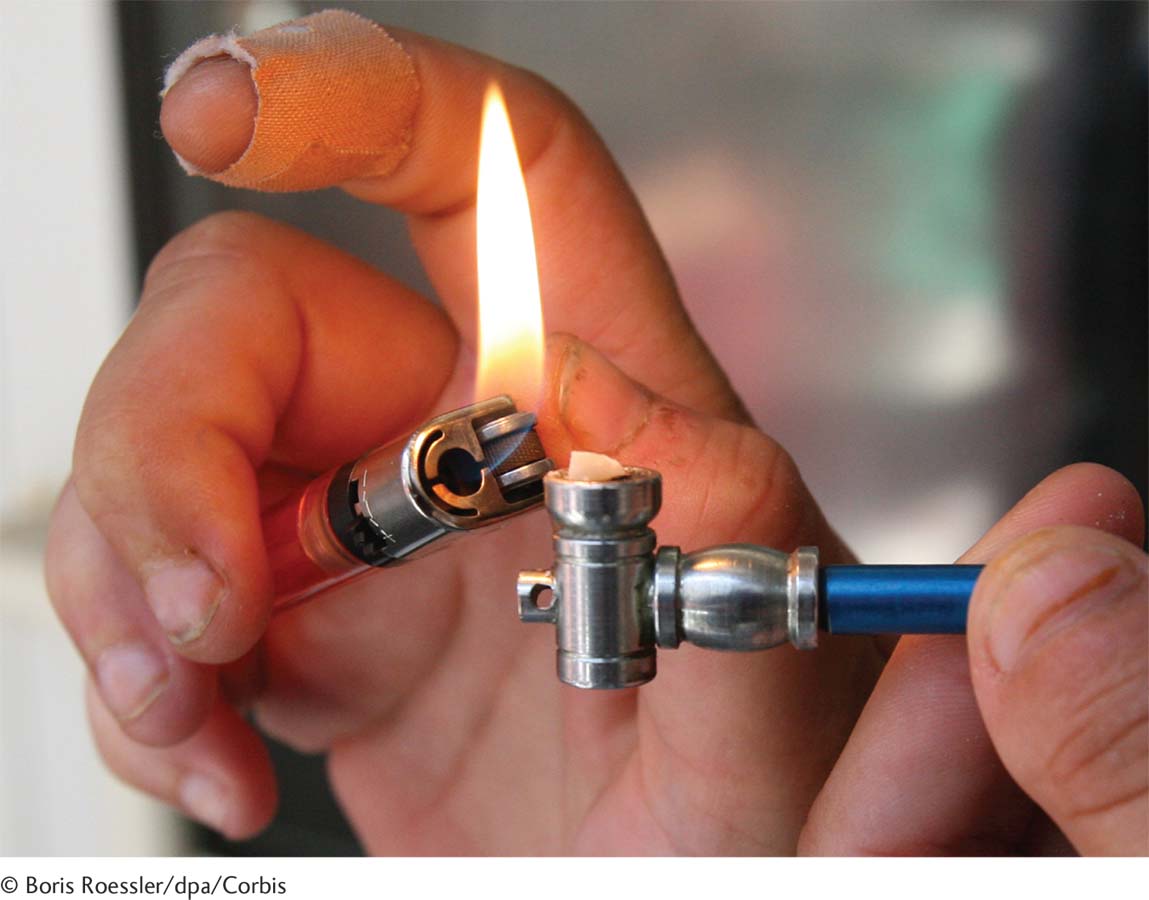10.2 Stimulants
Stimulants are substances that increase the activity of the central nervous system, resulting in increased blood pressure and heart rate, more alertness, and sped-
Cocaine
cocaine An addictive stimulant obtained from the coca plant. It is the most powerful natural stimulant known.
Cocaine—the central active ingredient of the coca plant, found in South America—
For years people believed that cocaine posed few problems aside from intoxication and, on occasion, temporary psychosis (see Table 10.2). Only later did researchers come to appreciate its many dangers (Haile, 2012). Their insights came after society witnessed a dramatic surge in the drug’s popularity and in problems related to its use. In the early 1960s, an estimated 10,000 people in the United States had tried cocaine. Today 28 million people have tried it, and 1.6 million—

Cocaine brings on a euphoric rush of well-

InfoCentral
SMOKING, TOBACCO, AND NICOTINE
Around 27% percent of all Americans over the age of 11 regularly smoke tobacco—

Cocaine apparently produces these effects largely by increasing supplies of the neurotransmitter dopamine at key neurons throughout the brain (Haile, 2012). Excessive amounts of dopamine travel to receiving neurons throughout the central nervous system and overstimulate them. Cocaine appears to also increase the activity of the neurotransmitters norepinephrine and serotonin in some areas of the brain (Hart & Ksir, 2014).
High doses of the drug produce cocaine intoxication, whose symptoms are poor muscle coordination, grandiosity, bad judgment, anger, aggression, compulsive behavior, anxiety, and confusion. Some people have hallucinations, delusions, or both.
A young man described how, after free-
(Allen, 1985, pp. 19–
As the stimulant effects of cocaine subside, the user goes through a depression-
free-

Ingesting Cocaine In the past, cocaine use and impact were limited by the drug’s high cost. Moreover, cocaine was usually snorted, a form of ingestion that has less powerful effects than either smoking or injection (Haile, 2012). Since 1984, however, the availability of newer, more powerful, and sometimes cheaper forms of cocaine has produced an enormous increase in the use of the drug. For example, many people now ingest cocaine by free-
crack A powerful, ready-
Millions more people use crack, a powerful form of free-
What Are the Dangers of Cocaine? Aside from cocaine’s harmful effects on behavior, cognition, and emotion, the drug poses serious physical dangers (NIH, 2015; Paczynski & Gold, 2011). The growth in the use of the powerful forms of cocaine has caused the annual number of cocaine-
The greatest danger of cocaine use is an overdose. Excessive doses have a strong effect on the respiratory center of the brain, at first stimulating it and then depressing it to the point where breathing may stop. Cocaine can also create major, even fatal, heart irregularities or brain seizures that bring breathing or heart functioning to a sudden stop (Acosta et al., 2011, 2005). In addition, pregnant women who use cocaine run the risk of having a miscarriage and of having children with predispositions to later drug use and with abnormalities in immune functioning, attention and learning, thyroid size, and dopamine and serotonin activity in the brain (Minnes et al., 2014; Kosten et al., 2008).
Amphetamines
amphetamine A stimulant drug that is manufactured in the laboratory.
Amphetamines are stimulant drugs that are manufactured in the laboratory. Some common examples are amphetamine (Benzedrine), dextroamphetamine (Dexedrine), and methamphetamine (Methedrine). First produced in the 1930s to help treat asthma, amphetamines soon became popular among people trying to lose weight; athletes seeking an extra burst of energy; soldiers, truck drivers, and pilots trying to stay awake; and students studying for exams through the night (Haile, 2012). Physicians now know the drugs are far too dangerous to be used so casually, and they prescribe them much less freely.
Amphetamines are most often taken in pill or capsule form, although some people inject the drugs intravenously or smoke them for a quicker, more powerful effect. Like cocaine, amphetamines increase energy and alertness and reduce appetite when taken in small doses; produce a rush, intoxication, and psychosis in high doses; and cause an emotional letdown as they leave the body. Also like cocaine, amphetamines stimulate the central nervous system by increasing the release of the neurotransmitters dopamine, norepinephrine, and serotonin throughout the brain, although the actions of amphetamines differ somewhat from those of cocaine (Hart & Ksir, 2014; Haile, 2012).

methamphetamine A powerful amphetamine drug that has surged in popularity in recent years, posing major health and law enforcement problems.
One kind of amphetamine, methamphetamine (nicknamed crank), has surged in popularity in recent years and so warrants special focus. Almost 6 percent of all people over the age of 11 in the United States have used methamphetamine at least once. Around 0.2 percent use it currently (NSDUH, 2013). It is available in the form of crystals (also known by the street names ice and crystal meth), which users smoke.
Most of the nonmedical methamphetamine in the United States is made in small “stovetop laboratories,” which typically operate for a few days in a remote area and then move on to a new—
Since 1989, when the media first began reporting about the dangers of smoking methamphetamine crystals, the rise in usage has been dramatic. Correspondingly, methamphetamine-
Methamphetamine is about as likely to be used by women as men. Around 40 percent of current users are women (NSDUH, 2013). The drug is particularly popular today among biker gangs, rural Americans, and urban gay communities and has gained wide use as a “club drug,” the term for those drugs that regularly find their way to all-
Like other kinds of amphetamines, methamphetamine increases activity of the neurotransmitters dopamine, serotonin, and norepinephrine, producing increased arousal, attention, and related effects (Yu et al., 2015; Acosta et al., 2011, 2005). It can have serious negative effects on a user’s physical, mental, and social life. Of particular concern is that it damages nerve endings. But users focus more on methamphetamine’s immediate positive impact, including perceptions by many that it makes them feel hypersexual and uninhibited (Washton & Zweben, 2008; Jefferson, 2005).
Stimulant Use Disorder

Regular use of either cocaine or amphetamines may lead to stimulant use disorder. The stimulant comes to dominate the person’s life, and the person may remain under the drug’s effects much of each day and function poorly in social relationships and at work. Regular stimulant use may also cause problems in short-
Summing Up
STIMULANTS Stimulants, including cocaine, amphetamines, caffeine, and nicotine, are substances that increase the activity of the central nervous system. Abnormal use of cocaine or amphetamines can lead to stimulant use disorder. Stimulants produce their effects by increasing the activity of dopamine, norepinephrine, and serotonin in the brain.